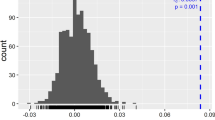Abstract
Although originally domesticated in tropical America, the sweetpotato [Ipomoea batatas (L.) Lam.] has a long history of cultivation in the Pacific region. While the post-Columbus dispersal of sweetpotato to Asia and the Pacific is well documented, the hypothesis that there was a prehistoric transfer of sweetpotato by Peruvian or Polynesian voyagers from Peru to Oceania has long been a controversial issue. The objective of this study was to assess the genetic diversity and interrelationships of sweetpotato landraces from the Pacific region and Latin America, and test the hypothesis of human transfer of this crop to the Pacific Island in prehistoric times. Seventy-five sweetpotato landraces from Peru, Ecuador, Mexico, the Philippines, Papua New Guinea (PNG) and 5 Oceania countries were analyzed using amplified fragment length polymorphism (AFLP). Multidimensional scaling (MDS) and analysis of molecular variance (AMOVA) revealed a large genetic variation in the Oceania gene pool, far greater than that in Peru-Ecuador. The Mexican cultivars were grouped together with those of Oceania. In contrast, there is little association between the Peru-Ecuador germplasm and that of Oceania. These results suggest that Peru-Ecuador may not be the source of the Oceania sweetpotato germplasm. Natural dispersal from Mesoamerica is an alternative explanation, to the ‘Kumara hypothesis’, for the origin of the Oceania sweetpotato.
Similar content being viewed by others
References
Armstrong J., Gibbs A., Peakall R. and Weiller G. 1995. RAPDistance, Package Manual. Version 1.03. Australian National University, Canberra.
Austin D.F. 1988. The taxonomy, evolution and genetic diversity of sweetpotatoes and related wild species. In: Gregory P. (ed.), Exploration, maintenance, and utilization of sweetpotato genetic resources. Intl. Potato Ctr., Lima, Peru, pp. 27–60.
Austin D.F. and Huamán Z. 1996. A synopsis of Ipomoea (Convolvulaceae) in the Americas. Taxon 45: 3–38.
Doyle J.J. and Doyle J.L. 1990. Isolation of plant DNA from fresh tissue. Focus 12: 13–15.
Emory K.P. 1968. Review of reports of the Norwegian archaeological expedition to Easter Island and the east Pacific. Vol.2. Miscellaneous Papers. American Anthropologist 70: 152–154.
Excoffier L., Smouse P.E. and Quattro J.M. 1992. Analysis of molecular variance inferred from metric distances among DNA haplotypes. applications to human mitochondria DNA restriction data. Genetics 131: 479–491.
Excoffier L. and Smouse P.E. 1994. Using allele frequencies and geographic subdivision to reconstruct gene trees within a species: molecular variance parsimony. Genetics 136: 343–359.
Heyerdahl T. 1950. The voyage of the raft Kon-Tiki. Geog. Jour. 115: 20–41.
Huang J.C. and Sun M. 2000. Genetic diversity and relationships of sweetpotato and its wild relatives in Ipomoea series Batatas (Convolvulaceae) as revealed by intersimple sequence repeat (ISSR) and restriction analysis of chloroplast DNA. TAG 100: 1050–1060.
Huang J.C. 2001. Analysis of genetic diversity in a sweetpotato (Ipomoea batatas) germplasm collection from Asia using amplified fragment length polymorphism (AFLP). PhD thesis, Hongkong University, Hongkong.
Huamán Z. and Zhang D.P. 1997. Sweetpotato. In: Fuccillo D. (ed.), Biodiversity in Trust – Conservation and Use of Plant Genetic Resources in CGIAR Centers. Cambridge University Press, Cambridge, UK, pp. 29–38.
Jarret R.L. and Austin D.F. 1994. Genetic diversity and systematic relationships in sweetpotato [Ipomoea batatas (L.) Lam.] and related species as revealed by RAPD analysis. Genetic Resources and Crop Evolution 41: 165–173.
O'Brien P.J. 1972. The sweetpotato. its origin and dispersal. American Anthropologist 74: 343–365.
Ridley H.N. 1930. The dispersal of plants throughout the world. Ashford, Reeve.
SAS Institute 1997. SAS/STAT Software. Changes and Enhancements through Release 6.12. SAS Inst. Inc., Cary, N.C.
Ugent D. and Peterson L. 1988. Archeological remains of potato and sweetpotato in Peru. CIP Circular 16: 1–10.
Vos P., Hogers R., Bleeker M., Reijans M., van der Lee T., Hornes M. et al. 1995. AFLP. A new technique for DNA fingerprinting. Nucleic Acid Research 23: 4407–4414.
Yen D.E. 1974. The sweetpotato and Oceania. An assay in ethnobotany. Bishop Museum Press, Hawaii, USA, Bernice P. Bishop Museum Bulletin 236.
Yen D.E. 1982. Sweetpotato in historical perspective. In: Villareal R.L. and Griggs T.D. (eds), Sweet Potato, Proceedings of First International Symposium. AVRDC Publ. No. 82–172, Tainan, Taiwan, pp. 17–30.
Yen D.E. 1991. The social impact of sweetpotato introduction in Asia and the South Pacific. In: UPWARD Sweetpotato cultures of Asia and South Pacific. Proceedings of the 2nd Annual UPWARD Intl. Conference, Los Baños, Philippines. pp. 18–27.
Zhang D.P., Ghislain M., Huamán Z. and Hijmans R.J. 1998. RAPD variation in sweetpotato [Ipomoea batatas (L.) Lam.] cultivars from South America and Papua New Guinea. Genetic Resources and Crop Evolution 45: 271–277.
Zhang D.P., Cervantes J., Huamán Z., Carey E. and Ghislain M. 2000. Assessing genetic diversity of sweet potato (Ipomoea batatas (L.) Lam.) cultivars from tropical America using AFLP. Genetic Resources and Crop Evolution 47: 659–665.
Author information
Authors and Affiliations
Corresponding author
Rights and permissions
About this article
Cite this article
Zhang, D., Rossel, G., Kriegner, A. et al. AFLP assessment of diversity in sweetpotato from Latin America and the Pacific region: Its implications on the dispersal of the crop. Genetic Resources and Crop Evolution 51, 115–120 (2004). https://doi.org/10.1023/B:GRES.0000020853.04508.a0
Issue Date:
DOI: https://doi.org/10.1023/B:GRES.0000020853.04508.a0




